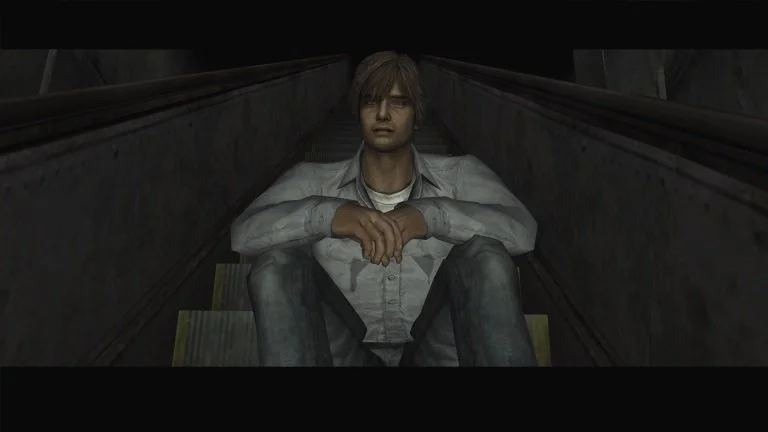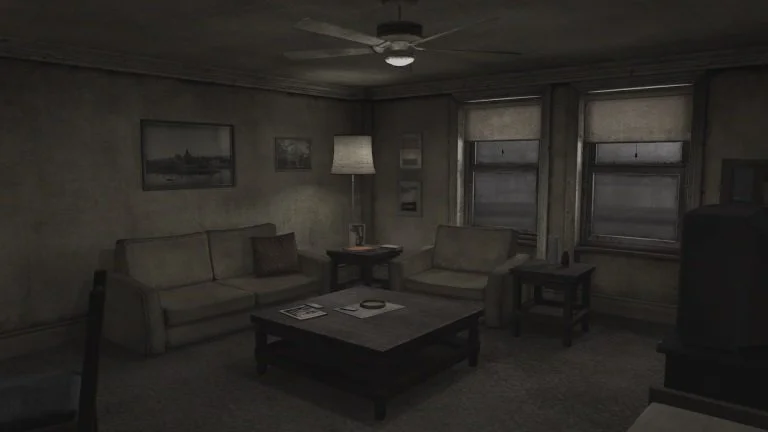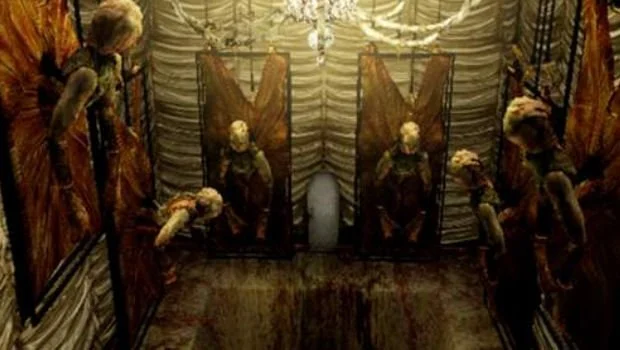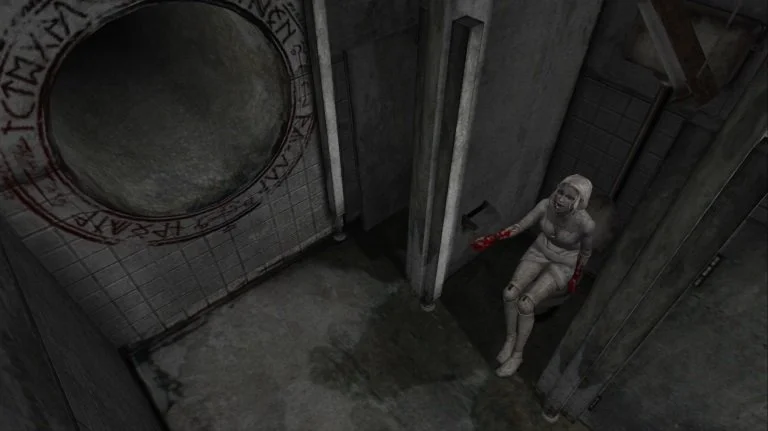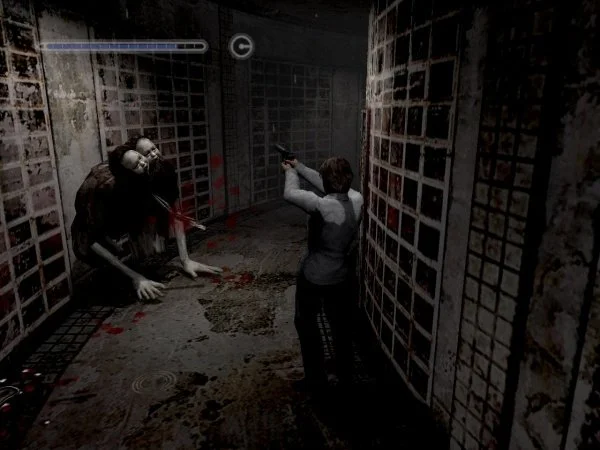Repost: Silent Hill 4
By the time Team Silent’s fourth and final horror effort was nearing release, the gaming landscape had changed significantly, mostly due to one thing: Resident Evil 4, a ground-up reinvention of the horror genre that kicked survival horror to the curb in favor of faster-paced “survival action”. While Silent Hill 4 came out several months earlier, Resident Evil 4’s huge departure from its roots and innovative gameplay had already been well established by pre-release coverage in the gaming press, and as a result Konami found themselves in the unenviable position of releasing a game that suddenly looked outdated and old-fashioned.
To be fair, Silent Hill 4 was by far the biggest departure from the formula established in Silent Hill 1, mixing up a number of mechanics and traditional elements that had been faithfully carried over across two sequels. Was it enough to make Team Silent’s swan song stand out compared to Capcom’s coming blockbuster?
The Story
Henry Townsend is a quiet sort, a shy and introverted man living in a large town about half a day’s drive from Silent Hill call Ashfield. One day he wakes up to find that his apartment door has been chained shut from the inside, he can’t open or break any of the windows, all of the phones are dead and no one outside can hear him calling for help. Also, someone is slipping mysterious documents of an apparently occult nature under his door and there are bloody hand-prints appearing in the corridor outside that only he can see.
After three days of this, Henry wakes from a disturbing nightmare in which his apartment has transformed into a dilapidated nightmare version of itself (hmmm….) to find that a mysterious hole has appeared in his bathroom wall. Having nothing better to do, he climbs through it and appears in a monster-infested Otherworld. Over the course of the game Henry travels to a succession of these alternate dimensions, each time meeting another hapless stranger who always winds up dead despite his best efforts to prevent it, their bodies inscribed with ritualistic marks and numbers. Eventually Henry realizes that the deaths of his colleagues in terror bear a striking resemblance to a series of murders committed by one Walter Sullivan, a serial killer who has a childhood connection to an orphanage in Silent Hill run by an insular little religious group that some people claim are actually an abusive cult, although of course that couldn’t possibly be true.
*cough*
Walter Sullivan killed himself in prison years before the start of the game, but it seems his ghostly and unfortunately unkillable presence is still at work, attempting to complete the ritual he started and summon his long lost “holy mother” back into the world. And of course, Henry and his attractive neighbor Eileen have an important role to play in all of this.
One aspect of Silent Hill 4’s story that people tend to miss even after playing the game is that Henry Townsend is not actually the main character—Walter Sullivan is. We do the whole “exploring a character’s mind through the medium of parallel dimensions and freaky monsters” thing again, and all of that symbolism is firmly focused on Walter; Henry by comparison remains more or less undeveloped as a character.
Before we get off the story section I’d like to point out something interesting about the Order, namely the fact that mental and physical child abuse is brought up in every game in which they play a narrative role. There’s of course poor Alessa being burned alive (and beaten by her mother for years before that), Claudia Wolf from Silent Hill 3 is implied to have suffered similar abuse from her own parents and in Silent Hill 4 it’s revealed the abuse was systemic and institutionalized (the orphanage Walter grew up in has a nearby secret prison that orphans were sent to if they failed to meet the ridiculously high standards of behavior expected of them, or sometimes just for the lulz). Two of the mobile phone spin-off games that I never got around to looking at took place in another, different Order-run institution that’s just as bad, although I’m not sure if they’re entirely in canon with the rest of the series. This theme is always present in the background, but as far as I know the games have never directly revealed what the deal is with all of this, apart from maybe being a dig at religious institutions like the Catholic Church that have a less then stellar track record when it comes to caring for children (some of the imagery associated with the Order is very obviously inspired by Catholicism).
Gameplay
The same old rapidly-aging puzzle and combat mechanics are back for another whirl, but this time around the fog world/Otherworld mechanic has been replaced with the apartment/Otherworld mechanic. While in the apartment, which you can return to any time, the game is played from a first-person perspective. During these segments the player reads new documents and clues to uncover more of the plot. Occasionally “hauntings”—unusual ghostly phenomenon—will manifest and drain health when you’re nearby until you use an item to make them go away.
Out in the various Otherworlds—now split into discrete stages—you can encounter ghosts that can float through walls and can’t be killed, although you can use items you find to immobilize them. Later on Walter plays the Pyramid Head role, popping up from time to time to try and shoot Henry in the face. During combat an on-screen health bar appears, in contrast to previous games where you had to go into the inventory to see how close to death you were.
These were all interesting changes to the Silent Hill formula, particularly the first-person apartment segments, but a less welcome addition was a limited inventory that forces the player to return to the apartment to swap out items. One of the ways the first Silent Hill had actually differed substantially from Resident Evil when it came out was the fact that it didn’t use a limited inventory system, so the decision to include it here after three games was baffling. Also somewhat frustrating is that despite not using the “explore an area in the for world and then explore it again in the Otherworld” the game still comes up with a reason to make the player go through each area twice, except with much less variation between the visits.
Over all Silent Hill 4 appears on the surface to change up the Silent Hill 4 formula quite a lot, but it really doesn’t. You’re still going to be spending upwards of 80% of your time exploring empty locations, fighting monsters and solving puzzles, none of which is substantially different from how it worked in the previous three games.
Development
At this point I have to take some time to refute a common misconception about Silent Hill 4. It is often claimed- sometimes as a justification for why it’s not a “real” Silent Hill title- that this game wasn’t initially supposed to be part of the franchise at all, but was made into a Silent Hill game at some point in development.
This isn’t really the case. Silent Hill 4 was made alongside Silent Hill 3 and while it’s true that initially is was going to be called Room 306, with no Silent Hill title, this doesn’t mean it wasn’t connected to the franchise, just that it was to be a spin-off. By the time development began in earnest the game was firmly established as the next entry in the series, and thus any claims about it not being a “real” Silent Hill game are pretty meaningless.
That aside, Silent Hill 4 represents something that I don’t think a lot of fans realize even to this day: how intangible the whole idea of “Team Silent” always was. As we saw, the original series creator left after the first game, and Silent Hill 4 saw the departure of art director Masahiro Ito, another key creative who had shaped the series’ identity. And of course the whole team disbanded after this game, with only Yamaoka and McGlynn still attached to future installments. And yet a decade later, fans were still greeting announcements of new Silent Hill games with “TEAM SILENT OR GTFO”, unaware that Team Silent doesn’t exist any more and was always more of a nebulous concept than a concrete entity.
(In the years since I wrote the original version of this post, this misconception seems to have largely been rectified).
The horror
Silent Hill’s approach to horror differs greatly from its predecessors in that, it, um isn’t as scary.
I know this is jumping the gun on the review material, but there’s not a whole lot more I can say about it than that. It’s just not as scary. For some reason the flashlight that features in every other Silent Hill ever is absent this time around, which means that the environments are much more brightly lit to compensate. Yes, you can certainly create horror without darkness but Silent Hill 4 is hamstrung in this regard by another flaw: notably inferior art design. Gone are Masahiro Ito’s wonderfully disturbing hellscapes, replaced by a succession of environments whose main distinguishing feature is an over-riding fondness of the colour grey.
That’s not to imply the game has nothing going for it in the horror department. There are one or two real standout locations, easily among the most memorable in the series, and some of the enemies are neat.
Interestingly, the monster designs this time around show some strong influence from Japanese horror films and games, with one of the invincible ghosts taking the form of a textbook case of the stringy-haired ghost girl that The Ring popularized. It’s a nice change of pace and leads to some cool stuff like the two-headed baby below, but I found that the creatures are consistently less scary than in previous games.
In terms of our occult/psychology scale I’d definitely put Silent Hill 4 over on the occult side of things—the plot revolves around an elaborate occult ritual, after all—but not as far as the first or third games were. A heavy focus is placed on delving into Walter Sullivan’s background and psychology in a way that we never got with Alessa, and ultimately his actions are fueled by psychosis and a major break from reality brought on by childhood trauma, as opposed to grand ambitions to reawaken God or usher in paradise.
The concept of the Otherworld is somewhat mixed up in this game compared to how it was portrayed in earlier titles, or would be portrayed in later games. This time around they’re explicitly presented as being created by Walter as a deliberate move to further his plans, rather than an unintentional by-product conjured to life by supernatural background forces, and he appears to have full control over them. This doesn’t break with the series tradition of obscuring the identity and nature of the occult forces at work in Silent Hill—Walter is still drawing on powers outside of himself whose origins we never learn, and it’s not at all clear that the being he summons as the culmination of his plan is actually what he thinks it is—but it’s an interesting way to have the supernatural goings-on personified in the guise of a major villain, as previous Silent Hill antagonists before this were always portrayed as essentially ordinary people interacting with forces that they may or may not have any objective understanding of. By the time the game begins, Walter has firmly left behind his mortal body and become an unkillable supernatural being, able to traverse his personal Otherworlds with impunity.
Inspirations
We’ve got a slew of film references again, although not quite as explicit as before. Apparently (I haven’t seen it) some of the mindscape-Otherworlds you travel through may have been inspired by the film The Cell, which also involves a serial killer.
The first person Henry meets after crawling through his hole traipses around the place with no concern for her safety because she initially believes she’s in a dream, only to later get murdered by Walter and die in real life (this happens in an Otherworld subway, and in a cool little scene, if you look out the window of your apartment afterward you can see her body being taken out of the real subway by paramedics), which bares a pretty strong resemblance to how Freddy Krueger kills his victims in Nightmare On Elm Street.
One of the developers stated in an interview that the game’s scenario came from a Japanese novel called Coin Locker Babies, although just from reading a description of it I’m not entirely sure what the connection is.
More generally the game shows a marked move toward more Japanese influences in its approach to horror. I already mentioned the floaty ghosts, some of which are very similar to what you tend to find in J-horror movies, but there’s also the idea of the antagonist as an invincible being who you can’t just shoot or stab in the face. In previous Silent Hill games even entities considered to be Gods can be killed by normal means (this may be because they’re always summoned in an incomplete or weakened form) whereas Walter and the ghosts are impervious to normal damage and require special occult items to combat.
In my opinion (and I’m far from the first person to make this observation), one of the big differences between American and Asian approaches to horror is that in American horror the threat tends to come in the guise of beings or entities that can on some level be fought against, whether that’s with a shotgun blast to the face or an exorcism, whereas in Asian horror ghosts and supernatural entities tend to be more or less unstoppable, operating more like curses than like creatures that you can run away from or fight; the most you can generally hope for is to convince the ghost to stop coming after you personally, sometimes by basically giving it what it wants, a la Sadako in The Ring. I’m obviously generalizing hugely here, but based on the rather wide selection of horror films and stories I’ve sampled from the two regions, that’s how I’d broadly characterize them, and Silent Hill 4 definitely seems to incorporate more aspects of Asian horror than any other game in the franchise.
The Music
Who wants some more awesome music? Well you’re only going to partially get it, as Yamaoka’s soundtrack this time around is in my opinion probably the weakest of the original four Silent Hill games, but the vocal tracks were pretty excellent (and unusually actually show up in the game itself), such as “Room of Angel”, the song that played over an epic 10-minute trailer for the game (shown during its entirety at E3 2004!).
We also get one of my favourite Silent Hill songs ever with this game, “Waiting For You”, which you can hear performed live below.
Also Tender Sugar, whose connection to the actual plot of the game I still have yet to figure out:
The Review
In my original review, I said that Silent Hill 4 was my second least favourite game in the series, implying that I thought Homecoming was better than it. I can only attribute this to the perfidious villainy of 2013 Ronan, who was a coward and a fool, because in hindsight that is a buck wild thing to say.
Don’t get me wrong: I still have major problems with this game. It’s still by far my least favourite of the Team Silent games. I still think Henry is a bowl of grey sludge and the inventory limitation is annoying and backtracking through the locations is tedious and the enemy designs aren’t as good as the older ones. And yes, Walter thinking that Henry’s apartment is his mother is still stupid.
But today, I appreciate what the game was going for a lot more. Ten years of indie horror games that use “pitch darkness = scary” as a design philosophy has made me re-evaluate how I feel about the lack of a flashlight and the subsequently brighter environments, and I think a lot of the Otherworld locations have a unique, subtle creepiness to them that didn’t stand out as much when I was comparing them more directly to the Otherworlds from the previous three games.
Mostly, what I appreciate about Silent Hill 4 is the fact that it was willing to depart so drastically from the series’ formula. It’s a shame that immediately after this Silent Hill was handed over to developers who, three times out of four, just went straight to apeing the aesthetics and style of the first three games.
For the sake of completeness, here is what I originally said about the game, edited only to remove my extremely regrettable use of the word “awesomeness”:
This is my second least favourite game in the franchise.
Part of me hates to say that, because Silent Hill 4 has a lot going for it. The apartment is a genuinely good idea with a lot of potential for creative scares and makes me wonder what, say, a Frictional Games-developed Silent Hill game in the style of Amnesia would be like. Team Silent showed an admirable ability to recognize that the format they had established three games ago was starting to get stale and took proactive steps to remedy the situation. The problem is that a lot of what they changed up didn’t work, and you had new experimental gameplay mechanics resting atop an already shaky foundation.
The game’s plot is good in theory. A Silent Hill serial killer story is a neat idea, but it’s hamstrung by how needlessly confusing and convoluted the story is. You spend way more time in Silent Hill 4 reading notes and documents than in the previous games, usually to unravel the minutiae of the occult rituals Walter is getting up to, which quickly gets tiring.
Henry is by far the most boring character in a franchise that has no shortage of dull main characters. I know I said that Walter is technically the protagonist, but that doesn’t change the fact that you’re playing as Henry for the entire game. My level of interest in him isn’t helped by the fact that he’s basically a clueless chump who got thrown into the story by dint of being in the wrong place at the wrong time and has no actual emotional stakes in anything that happens beyond rescuing his hot neighbor, a shallow damsel in distress who’s extremely disappointing after Heather in the third game. Walter is a cool and interesting villain, but there’s no getting around the fact that his motivation stems from the inherently stupid idea that he believes Henry’s apartment is his mother (don’t ask). None of this is helped by the fact that the voice acting is somehow worse than Silent Hill 3’s.
By this point the original Silent Hill’s creaky old combat system, which had been ported over essentially unchanged across the second and third games, was becoming more and more of a flaw, especially once the gaming public got wind of Resident Evil 4 and its spin-kick heavy fast paced shooty-stabby combat mechanics. The inclusion of an on-screen health bar is a welcome touch, but the only other real attempt to spice up the combat is by increasing the number of enemies you encounter. As you may be able to guess, this doesn’t really achieve anything except to make the game more frustrating.
Like I said in the horror section, Silent Hill 4 is markedly less scary than its predecessors. As we’ll see later in this post series I am perfectly willing to accept a non-scary Silent Hill game, but what I can’t accept is a Silent Hill game that’s both not scary and boring. Making the player go through each level twice is galling enough, but now keep in mind that the second time around there are invincible ghosts flying through walls at you and also you’ll probably have to go back to the item box in your apartment quite often to swap out gear—oh and also, if you accepted the totally innocuous looking doll Walter offers you the first time you meet him, doing this also damages you. This wasn’t the first time a Silent Hill game trolled the player (in Silent Hill 3 you get a strange perfume which if used has no other effect than to make nurse monsters spawn more often in the hospital) but it’s by far the most frustrating example. And also you have Eileen following you around for quite a lot of this, and she can both die and possesses the survival instincts of a legless badger crossing a motorway.
Again, I really wish I could write about Silent Hill 4 more positively because I genuinely think its heart is in the right place. But a game can’t get by on heart alone, and so I must consign Silent Hill 4 the dubious honor of being named the first major mis-step in the franchise.
Should you play it?
It definitely shouldn’t be your first Silent Hill game, but if you decide you like the series, definitely check Silent Hill 4 out, if only for the novelty factor. Maybe you’ll end up really liking it!
For once, if you’re interested in playing it then I can just throw you a link: here it is, available to purchase on GOG for only eleven smackeroonies. For some reason, a few years ago Konami released this game, and only this game, on the platform. I have absolutely no idea why they didn’t throw the rest of them up there as well.
Apparently the GOG version has some technical issues, but fan-made fixes are easily located with a simple Google search.
Legacy
In the years since I wrote the original version of this post, Silent Hill 4 has undergone a quite startling re-appraisal among the fanbase. Go onto r/SilentHill, and you’ll often see people praising it as their favourite game in the series, almost as often as Silent Hill 2. I don’t agree with them, but it’s kind of heartwarming to see this strange, plucky experiment getting so much love twenty years after it came out.
That latter day appreciation might extend beyond the fanbase. While the Silent Hill 2 remake includes references to all of the Team Silent, it references Silent Hill 4 more often than 1 or 3, to kind of an odd extent. Konami also madea promotional ARG site for the remake, which also contains multiple Silent Hill 4 references.
All of this has led people to speculate: could Bloober Team be doing a Silent Hill 4 remake next? It wouldn’t be as quixotic an idea as it might sound. Remaking Silent Hill 3 before Silent Hill 1 is pretty much a non-starter given that the former is a direct sequel to the latter, and remaking Silent Hill 1 would basically involve scrapping the entire game and starting over, given how primitive its design now feels. By contrast, Silent Hill 4 is a completely stand-alone story which, as I hope I’ve demonstrated, has a lot of interesting ideas that could be used as a viable foundation.

